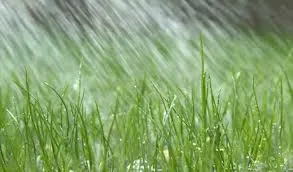Guess what it is doing outside while I write this on Tuesday? Raining, of course. I can’t think of the last time I have seen so much rain that was unrelated to a tropical storm or hurricane (Knock on wood!) We desperately need rain for our Gainesville lawn and landscape to remain healthy, but since we have gotten and are getting so much of it certain problems could be showing up in Gainesville landscape.
One particular problem is fungus and disease in turfgrass, mainly on St. Augustine and zoysia. Monday I was e-mailed pictures from two of our crews that had noticed clients who had leaf-spot fungus on their route. Many fruiting bodies of these fungi may suddenly appear on the blades of turfgrass in small patches. This calls for an immediate treatment of fungicide. If you have a Gainesville lawn treatment program, you should not hesitate to call them immediately. If you do not have a Gainesville lawn program, you have two options. Call us and we can get you set up on a Gainesville Fertilization program or you can contact your local home improvement store to see if they carry the right fix for your particular type of fungi.
If we get back to drier times and it shows up on your grass, it means you are runiing your Gainesville sprinkler system too often.
Another turfgrass disease that might have developed is dollar spot. Dollar spot appears as small tan-to-brown patches in the lawn. The best way you can tell if your grass has dollar spot is to go out in the morning when dew is on the ground and see if there is a white, cobwebby growth on the infected patches. Then look at the blades of grass up close and you should see small, gray or light tan lesions with reddish-brown margins.
This disease is a little different than the other ones we deal with around here. It usually occurs when the nitrogen levels available to the grass are inadequate and when there are heavy dews, particularly in May and June, then again in September and October. Last year it persisted all summer long on zoysia because of the humid summer temperatures, coupled with excessive rain and cloudy days.
With all the rain, much of the nitrogen Gainesville lawn fertilizer put out a couple of months ago is gone, so adding more fertilizer is generally sufficient control and usually allows the turf to outgrow the problem.
Shoes, garden hoses, mowers and other Gainesville lawn service equipment spread the fungus organisms, so you may have to let your lawn get a little overgrown while treating it so not to spread the problem into other areas of the lawn.
A lot of annual flowers in your Gainesville landscape such as vinca, petunias, geraniums, and begonias may get root rot fungus due to saturated soils. Symptoms of a plant with root rot are stunted growth, marginal leaf burn, wilting, yellowing, and general decline. These symptoms can be caused by other root problems such as nematodes, drought, low fertility, and/or improper planting, so a plant will have to be removed from the soil and examined to diagnose the problem.
The root system of affected plants is usually smaller than normal. Roots are fragile; they break apart easily when touched. Often, the outer portion of the root will strip away easily from the inner portion. Depending on the pathogen involved, the color of the roots may also show you something. Roots are usually a pale gray or honey color if infected with a disease called pythium. They are tan to brown if infected with Rhizoctonia, or streaked with black if infected by one we call black root rot. These are all root rot diseases. Once plants are displaying advanced symptoms, remove them because they cannot be cured.
Control for root rots should be more preventive. Proper planting (breaking up the root ball and planting in well-prepared soil) reduces the likelihood of root rot diseases. Incorporating compost can improve drainage in wet areas and reduce the incidence of root rot diseases. Elevating the grade of the bed by adding additional soil is also helpful to make sure excess water doesn’t puddle at the base of the plant.
If you have any other questions about how the weather can affect your lawn and landscape, please give our office a call at 378-LAWN. We are always here to help in any way possible.


